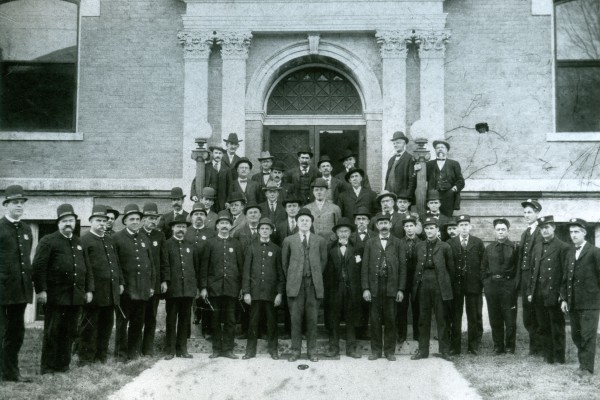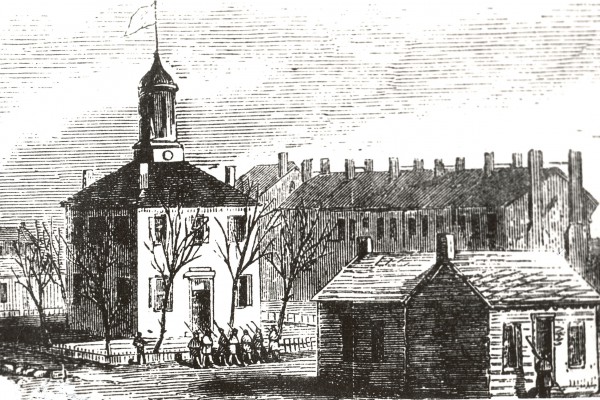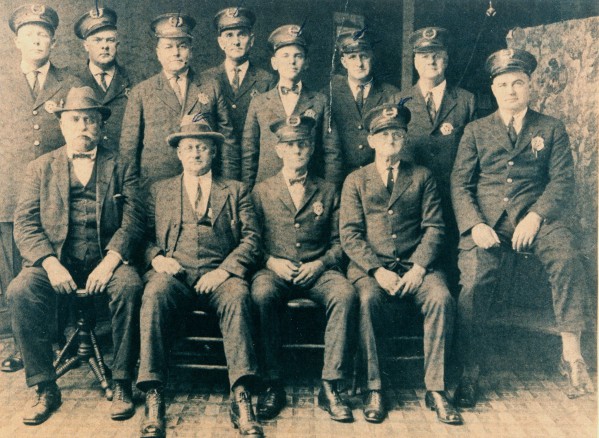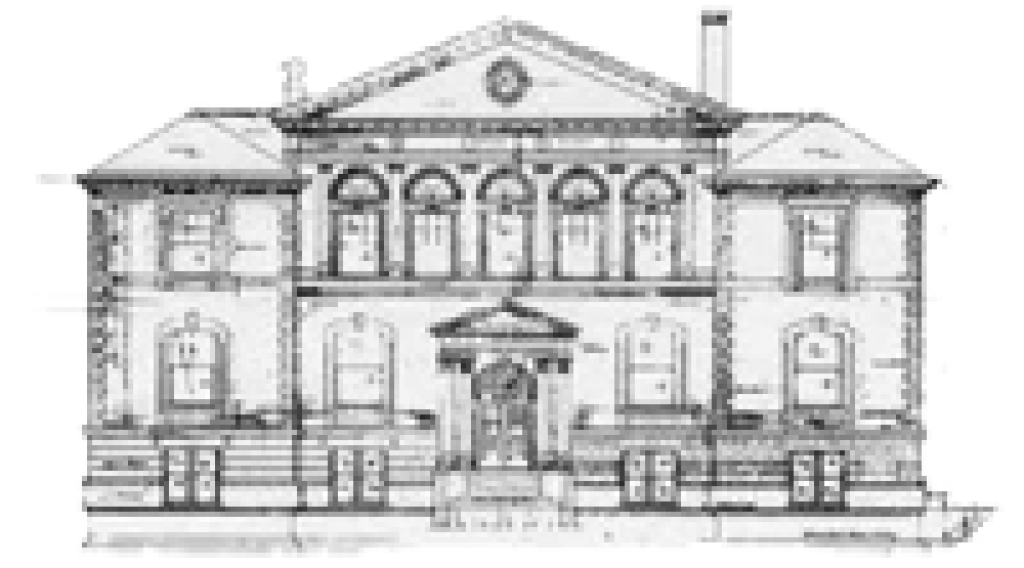History of Police Department

Bowling Green Police and Fire Departments with Mayor and City Officials Era 1900's
Photo Care of: Kentucky Library and Museum, Western Kentucky University
Early History
Settlement in the area of Bowling Green began with the establishment of a trading post on the Barren River known as McFadden’s Station in about 1785. Earlier, in 1775, thirteen long hunters had carved their names on a beech tree at another Barren River crossing. Warren County was formed from Logan County in 1796 and became the twenty-fourth county in Kentucky.
In the early 1790’s, Robert Moore built a cabin near a large spring in central Warren County not far from the Barren River. In 1797, Moore donated two acres near the spring for the building of a town square and a courthouse, and two years later, the spring was given for public use. A 20’x 20’ log courthouse and a 16’x 12’ jail were completed in the square by March 1798 and a board of commissioners named the town Bowling Green.
Between 1805 and 1809 a dispute arose concerning the choice of location for the circuit court. On February 3, 1808, the General Assembly ordered a commission formed to “explore” the county in order to fix the permanent seat of justice. Apparently the place found did not suit “a large portion of the citizens of Warren County,” so the General Assembly ordered on January 16, 1809 the court moved back to “the old public square in the town of Bowling Green.” In 1810 and 1812, the legislature passed Acts of incorporation and regulation for local government and by 1813, government functions were permanently fixed in Bowling Green.
The town’s first law enforcement officers were called “Watchmen.” The earliest surviving records show that these part— time officers were being used in 1823, although the system probably predates that time by a few years. Records of the Town Council show that on August 9, 1823, James Keel was appointed “Captain of the Pattrole” and John Potts and Isaac Bennings were appointed to assist. Keels pay consisted of not having to pay town taxes for the duration of his service. By June 1825, a system of 26 rotating “Watches” each consisting of a Captain, a Lieutenant and two privates, was set up for “patroleing” the town. A Captain who refused to do his duty could be fined $3.00; any other member could be fined $1.50 for failure or refusal.
Evidently that system did not last long, because at a regularly called meeting of the Board of Trustees on August 1, 1838, it was ordered that Jeremiah A. Robinson and Matthew M. Hare be appointed “patrolls for the Town..., and that they be required to patroll not to exceed three nights in each week and two hours in each night, ... and for the services ... required, they ... [should receive] two shillings for each hours service.” Apparently the officer in charge was called “the Marshall” for later that same month Andrew McCaney resigned as “the Marshall of the Town of Bowling Green” and Jeremiah A. Robinson was appointed in his place.
Between the 1830’s and the 1850’s Bowling Green became a major regional trading center. The first steamboat landed at Double Springs Landing in 1828 and subsequent improvements to the Green and Barren Rivers enabled regular steamboat navigation from the Mississippi and Ohio Rivers to the city by the late 1840’s. The completion of the L & N Railroad in August 1859 brought additional growth and prosperity and further made Bowling Green a major commercial center between Louisville and Nashville.
During the early years the system of part-time watchmen and patrols seemed adequate. Early census records show only 815 persons living in Bowling Green by 1830. But as the City grew, such a system could no longer keep pace with population demands. Certainly by 1860, with a population estimated to be about 2,000, the city could no longer be policed by part-time officers. Records show that by 1861 the town had at least one full-time officer (the Marshall) and probably assistant officers who also worked on a full-time basis. There was also a police court and a police judge at the time. These were all established in addition to the county’s court system and Sheriff’s office. The Sheriff primarily served the county court and could arrest anywhere within the county, but the town Marshall and police court’s authority was restricted to within the town limits. (The city police department today has county-wide investigative and arrest jurisdiction, but does not have the responsibility for policing the county outside the city limits.)
At a called meeting of the Board of Trustees held on the 24th of January 1861, ordinances were passed specifying the duties of town officials including those of the Marshall. The Police Judge and the Marshall, among other duties, were to see that all laws or ordinances relating to licenses were complied with. The Marshall had authority to arrest and detain; to execute warrants and summons; to clear streets, vacant lots and alleys of “nuisances,” and otherwise see to it that all ordinances of the town were observed. One part of his duty was to report monthly to the governing body the collection of certain moneys received on behalf of town government. In the early years, these included the collection of taxes, fines and proceeds from auctions. Part of this tradition was continued by Chiefs of Police at least through the 1940’s.
After the Civil War the Marshall’s office continued to expand. By the 1870’s the Marshall was called “Chief of Police.” At least two early City Directories called him both “Marshall and Chief of Police.” S.T. Adams was City Marshall and Chief in 1876 and the same term was applied to W.E. Mise in 1886. James A. Corbin was the last Marshall and Chief. According to the Common Council minutes, after Henry James was appointed Chief of Police on December 27, 1893, none of the department CEO’s were ever called Marshall again. References within the minutes of Council meetings prior to 1893 also refer to those working for the Marshall/Chief as both Deputy Marshalls and policemen.
Police Department Beginning
By 1893 the cities of the Commonwealth were classified into six classifications according to population. That year the General Assembly passed an Act making it a requirement for all Third Class cities, including Bowling Green at the time, to provide a police force. The statute stipulated that police salaries and appointments were to be made in December of each year. As a result of that Act, from December 1893 until the institution of the City Manager form of Government in 1968, vacant jobs within the department were generally filled only during council meetings in December each year. Also from that time through the early 1940’s, every four years when a new Mayor took office, a new Chief of Police was usually appointed. Appointees were nominated by the Police Committee and confirmed by vote of the entire Council. In order to obtain an appointment, apparently one had to be a white male and be able to obtain the backing of the Police Committee and a majority vote within the Council. (Today officers are appointed by the City Commission after qualification testing and upon the recommendation of the Chief of Police. Race and gender qualifications were changed during Chief Wayne Constant’s tenure, when the Council appointed Mary Potter in the early 1960’s as the department’s first female officer, and when the Commission appointed Joe Denning in 1968 as the first black officer.)
Henry James served as Chief of Police from 1893 until December 4, 1905 when R. E. Dillard was appointed. A 1905 City Directory printed before Dillard’s appointment shows the department consisting of eleven men including the Chief, a Depot Officer and a Station House Keeper. George T. Wilson was Mayor and George R. Garin was City Judge. From James’s appointment in 1893 to the present, sixteen Chiefs have served the department. (See list of Chiefs of Police attached.)
By 1905 Bowling Green’s population was a little over eleven thousand. The police department was headquartered at 1019 State Street, in or attached to a building housing a City/County Jail. City government offices were across the street at the corner of State Street and Tenth Avenue in the McCormack Building. Although not listed as such, it is assumed at this writing that Council Chambers were at the same location. However, city directories for 1876 list the location of the City Council Chamber as “ws State, s Court;” and for 1886 as “ws Summer street.” According to a city map printed in 1877, Court Street was the old name for Tenth Avenue and Summer Street the old name for College Street. Research for this paper has not yet revealed where facilities for city government and city law enforcement were located during the years prior to 1876. However, it is probably safe to say that the City Marshall’s office was located close to Police Court and available jail facilities and wherever the early City Council met.
According to Park City Daily News articles by John M. Rodes (April, 1917) and Mrs. Violet Pike (November 27, 1925), when the dispute arose concerning the location of Circuit Court between 1805 and 1809, the original log courthouse and jail built in the square in 1798 were moved to “Jeffersonville”, approximately where the city water works now stand close to the Barren River. After the court moved back to Bowling Green in 1812, a new brick court house was built in the old town square where the log court house had been. Apparently a log jail was also built. The 1812 Court House stood until the square was converted to a park between 1871 and 1872. The present County Court House on Tenth Avenue was built in
1868-1869. The jail at 1019 State Street was built about 1860 and was used along with the log jail in the square. The records do not show how long the log jail lasted, but the State Street jail stood until it was replaced by the County Jail built behind the County Court House in 1939 as a WPA project. It was apparently shared by both County and City governments to house prisoners.

Engraving of 1812 Brick Court House & Log Jail in City Square
Photo Care of: Kentucky Library and Museum, Western Kentucky University
Police Department Expands
The present City Hall at 1001 College Street was built in 1907 to house offices for city government and the police department. The police department and Police Court occupied the basement floor of the building and temporary hold-over jail cells were attached at the rear. The police department or a part of it remained in City Hall for 90 years, from 1907 to 1997, when the new building at 911 Kentucky Street was opened. Police Court remained until January, 1978 when the present District Court system began in Kentucky. George Boston was the last Police Court Judge for the City of Bowling Green.
City Hall’s cramped quarters had begun to be a problem for the department even before the court change of 1978. Not long after the court moved, the department ran out of space. Therefore, in 1970 it was necessary for everyone except the department’s Juvenile section to moved next door into the former Water Works office building at 1011 College Street. From 1970 through 1996, this building served as the Police Headquarters Building. By 1974 need for additional office space prompted the building of a second floor onto that building. The second floor was completed and occupied by February 1975, but during the early 1980’s the department had again outgrown its facilities. A parking shortage caused by the presence of construction equipment during City Hall’s renovation in 1986 made it necessary to move patrol shift change operations to the City Garage on Raven Street. Shift changes were later moved to the Police/Fire Training Center on Porter Pike and remained there until the opening of the present building in 1997 at 911 Kentucky Street. In a continuing quest for space, the offices for the Chief and most uniformed supervisory personnel were moved in 1987 to the Paxton House at 318 East Tenth Street and, in 1993 the first floor of the College Street Station was renovated to create more space for the Communications and Records sections. During all this time, in order to better utilize existing space, various offices for investigative personnel and others were periodically shifted back and forth between the basement of City Hall and the second floor of the College Street Station. Thus, from 1987 through 1996, the department operated from four basic locations: Administration from the Paxton House at 316 East Tenth St; Communication, Records, and Investigations from 1011 College Street; Patrol operations from the Training Center at 302 New Porter Pike; and Criminal Investigations and Community Relations from the basement of City Hall at 1001 College Street.
A photograph taken of department personnel on the steps of City Hall in 1907 show nine officers in uniform, including Chief Dillard, and the Station House Keeper. Those nine officers probably made up the entire department at the time and most of them probably served at least until December 1909 when Chief Rone was appointed. The minutes of the Common Council, no doubt name the officers appointed to serve with the Chief that year. But by the 1930’s, when a new Chief was appointed, it probably had become the practice of recording in the minutes the names of only newly hired patrolmen and new position appointees such as the position of Chief, instead of renaming everyone held over from previous administrations. For example, on December 18, 1939, Claude Thomas and D.H. Brown, were named as Chief and Assistant Chief, but only four patrol officers were appointed. No doubt a time-consuming examination of the minutes from 1893 to the present, would produce the name and position of every person ever hired for the department, but it would still not show the exact number of officers working at a given time, especially during the latter years. These roll call records should have been kept by the police department, but over the years they have been lost.
Gone too are many details about uniforms and equipment and the way officers worked. Early photographs show “Keystone Cop” uniforms; those taken later show styles of the particular photo’s time. The first patrols were walking beats, but when the city spread out, other methods were needed. Research for this paper has not determined when the department first purchased an automobile, but there was at least one vehicle by 1935 because the budget that year included $750 for “Gas, Oil and Grease.”
An old Kentucky Peace Officers Magazine article about Bowling Green relates that Chief Robert Monahan in 1941 had installed a cross index card filing system, fingerprinting equipment and photo Identification systems, and employed a motorcycle patrolman for traffic duty. That year Bowling Green also became the first department in the country to receive a two-way AM police radio system manufactured and installed by the Motorola Company. Licensed by the FCC on May 22, 1941, the system consisted of a small base station in the basement of City Hall and a mobile unit with large whip antenna mounted on the department’s one patrol car. After World War II, Haro Durham and Jack Hendricks installed the department’s first FM radio equipment. Before the days of the two-way radio, officers were instructed to drive past the police station every hour. If there was a call to make, the desk clerk would signal them to stop. When not signaled to stop, officers were instructed to drive on and be back in an hour.
In 1946 an old paddy wagon and one patrol car was in operation, but by 1950 the department had something called a “patrol wagon,” two patrol cars and two motorcycles. Bowling Green became a Second Class City that year (Feb. 2nd) and according to the Daily News (June 18 article) the police department was larger than it had ever been with a total of 28 uniformed officers and a $79,570 budget. Chief Murrell Waddle had attended an FBI Academy training course for police administrators and had begun to reorganize the department. The reorganization included a Civilian Clerk, Charles Hudson; a Traffic Specialist, Sgt. Dick Cash; an Identification Specialist, Hubert Phelps; Radio/Desk operators, D.A. Capps, Paul Stone and Moss Johnson; Patrol Supervisors, Sgts Curtis Henderson and Charles Miller; and the Assistant Chief, Frank Drake. An examination system was in place for new applicants and a training course was planned for the Fall. New equipment included: two-way mobile radio equipment for three vehicles, eight 12 gauge shotguns, two rifles, tear gas equipment and two “bulletproof” human-silhouette shields.
Setting Standards
Since Chief Waddle’s time, the department has reorganized several more times in order to keep up with what experts in the police field said should be done. In the Spring of 1962 the Washington-based International Association of Chiefs of Police (IACP) completed a police study for Bowling Green and recommended that the department be reorganized into three divisions: Patrol and Traffic, Investigation, and Service. This structure was kept until 1993 when another study recommended a basic organization of only two divisions: Patrol and Traffic, and Support Services. That year, the Public Administration Service Company (PAS) of McLean, Virginia not only recommended the new organizational structure but also a new operating philosophy: Community Oriented Policing (COP). Simply stated, COP says the police should work proactively with the community to solve problems instead of merely reacting to problems within the community. In the interim between 1962 and 1993, a study in 1977 by McCann Associates Inc. of Langhorne, PA., a professional testing company, established, in addition to minor organizational changes, a comprehensive entrance exam and promotional testing system. Entrance standards now consist of McCann’s standardized written exam, the MMPI psychological test and a physical agility test. The McCann testing and PAS organizational structure and COPs Program are currently considered by the department the best way to recruit, organize and deploy personnel.
In 1969, the Kentucky Bureau of Training in Richmond KY, now named the Kentucky Department of Criminal Justice Training (DOCJT), was created to train municipal police recruits throughout the state and to provide on-going annual in-service training. Since that time, every new officer has been required to complete a 18-week basic training course provided by the DOCJT and extensive Field Training prior to being placed on the job. Since 1980, every officer promoted to a first line supervisory position or above has had to complete extensive supervisory or administrative courses provided by the DOCJT, or the Southern Police Institute in Louisville KY., or the FBI National Academy in Washington DC. The department’s field training, the DOCJT’s in-service training and various courses provided by the Southern Police Institute, the FBI National Academy and other professional police training agencies currently make up the bulk of the department’s educational process. The department also encourages individual pursuit of university-level degrees.
In 1983, the department printed its first policy and procedures manual. Re-written in 1986 and updated since that time, the manual complies with standards of risk management and professional police standards recommended by the Commission on Accreditation of Law Enforcement Agencies and the Kentucky Association of Chiefs of Police. Standards govern every aspect from the basic police role and authority to specifics such as the department’s command, organization and general management, its fiscal management, and grievance and disciplinary systems, etc. In 1993, the department was accredited by the Kentucky Association of Chiefs of Police and is scheduled for re-accreditation during 1998.
Bowling Green now measures approximately 30 square miles and is the primary trade and business center for the County’s nearly 81,000 population. The City currently budgets 5.5 million dollars for all police services which include provisions for 90 sworn police officers, 58 full and part-time support personnel and the operation of over 50 vehicles. Since Chief Gary Raymer’s appointment in 1980, the department’s mission philosophy, organization, training and operating policies have all been rewritten in an effort to give Bowling Green the best police service possible.
With the retirement of Chief Gary Raymer, a new Chief was selected. On September 1, 2002, Bill Waltrip was promoted to Chief of Police.
With the retirement of Chief Bill Waltrip in 2006, Doug Hawkins was promoted to Chief of Police on November 1, 2006.

Members of the 1925 Bowling Green Police Department group photograph. The 11-member force included (front row, left to right) Mayor Henry Stone, Chief Romeo Craig, Joe Barriger, Ed Waddle and Patrolman Scott: back row, Bill Connelly, R.C. Shive Sr., Getty Lowe, Frank Hagerman, Bud Hinton, Wilby Gross and Bill Cassady.
Photo Care of: Kentucky Library and Museum, Western Kentucky University
Let us know if anything is wrong with this page. However, please don't include any personal or financial information.
